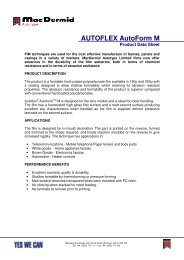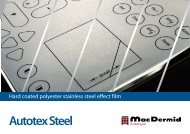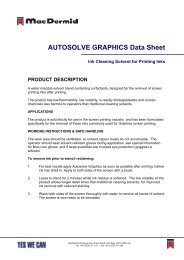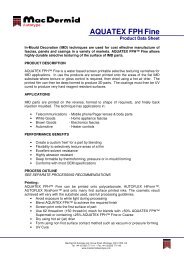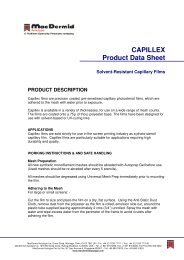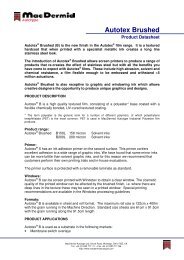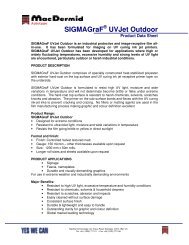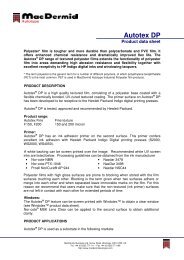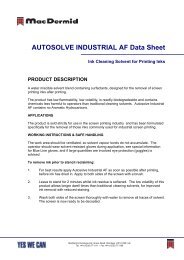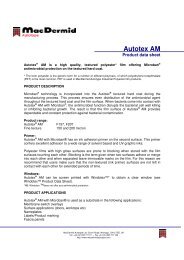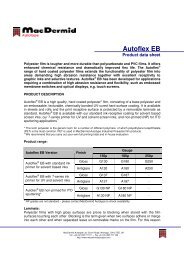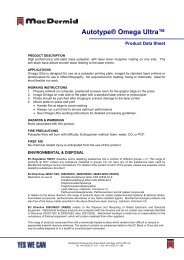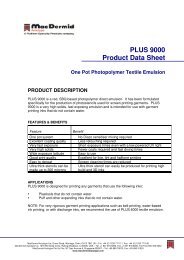Screen E-Book (.PDF) - MacDermid Autotype
Screen E-Book (.PDF) - MacDermid Autotype
Screen E-Book (.PDF) - MacDermid Autotype
- No tags were found...
Create successful ePaper yourself
Turn your PDF publications into a flip-book with our unique Google optimized e-Paper software.
ers. We no longer have fruitless debatesbased on visual impressions of microscopeimages, but hard numbers we can all agreeon. Our work on AI was particularly usefulin confirming that a low-EOM, low-Rzstencil was by far the best for printing lines.Not only was the AI high, it was almostindependent of press settings and angleof the line with respect to the squeegee.High-EOM or high-Rz stencils showedworse and highly variable AIs.MoiréWe come across this all the time. Ourdigital microscopes help us diagnose theproblems by following the ideas describedin the Moiré section of this e<strong>Book</strong>. All wecan say here from our experience in thefield is that the techniques described inthe moiré section really work!Printing very fine linesAs many printers are struggling with thechallenge of going down to 50µm andlower it’s worth summarizing here our recipefor success. Well, not quite. It’s a recipefor giving you the best chance of success.What’s important is that those who don’tfollow this recipe are guaranteed failure.We are very happy to offer this advice, andvery sad that each time it has been ignoredfailure is inevitable. We learned allthe mistakes the hard way when we firstembarked on our “50µm project” adventure.That’s how we became so confidentin the recipe.• Use the finest stainless mesh possible.We’ve loved using 16µm and have heard oflucky printers who have access to 13µm.• Use blackened stainless to ensure optimumprint exposure without losing resolutionfrom scattering. It’s hard to get holdof, but worth it.• Use a specialist low-Rz, low-EOM stencil– either Capillex CX or a multi-coat weton-dryemulsion (if you have the time andpatience).• Use a clean-room environment.• Find a reliable source of beautifullysharpened medium-to-hard sharp-profilesqueegees.• Set up your press with minimum snap-off(off-contact), minimum squeegee pressure(you’ve got a delicate mesh and an exquisitesqueegee!).• Insist that your ink supplier gives you ahigh-low-high, rapid recovery ink – asclose as possible to the printing behaviourof the cermet inks that are routinely usedin ceramic-based electronic printing. (SeeSteve’s ink design optional theory sectionfor an explanation).• Control slump through (a) the rapidrecoveryink, (b) a controlled (relativelyhigh) static contact angle of the ink withthe substrate and (c) as rapid a “cure” (UV,solvent evaporation, solvent absorption) aspossible. If you can control/understand thebeach effect you are in even better shape.(Again, see Steve’s ink section).• When you can’t reduce the slump anyfurther, reduce the width of the line in thefilm positive by the amount of the slump.91



